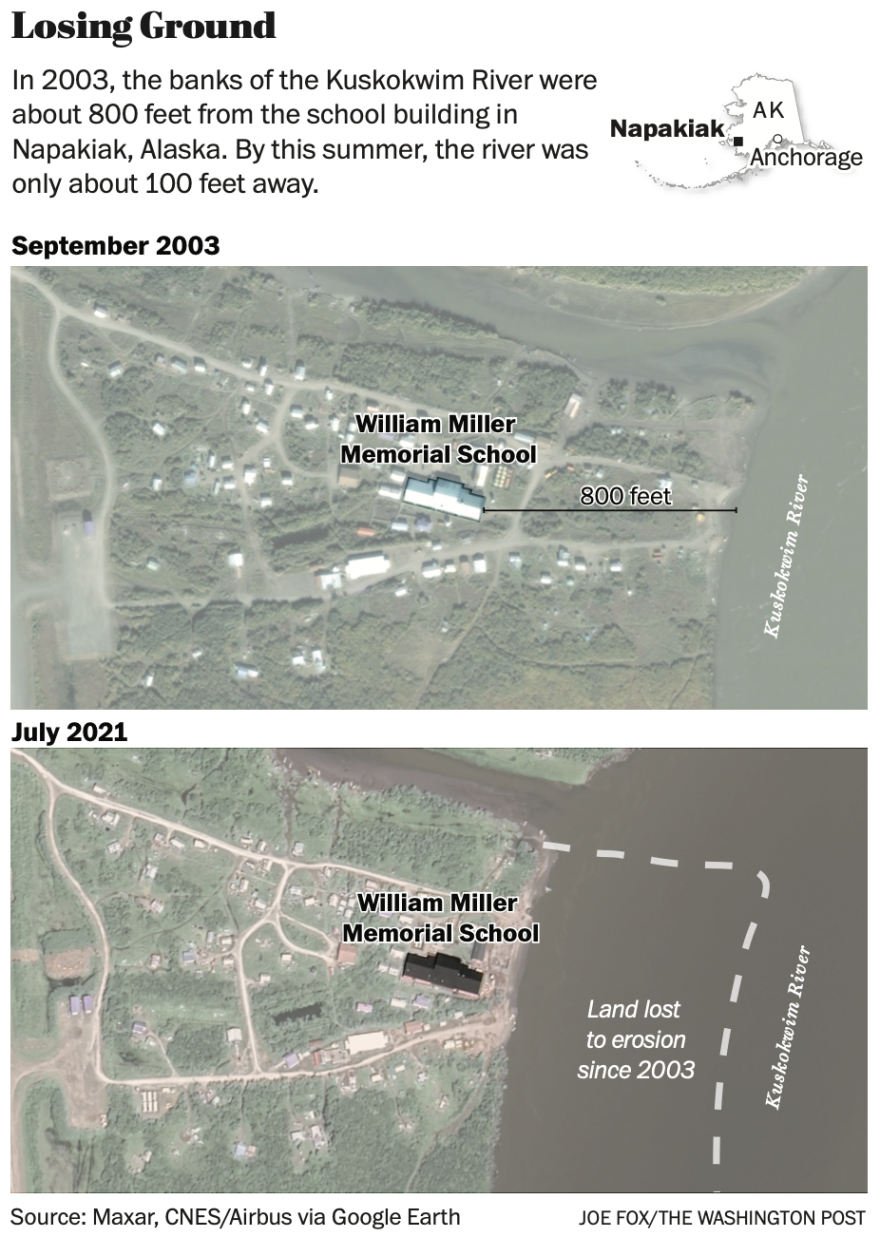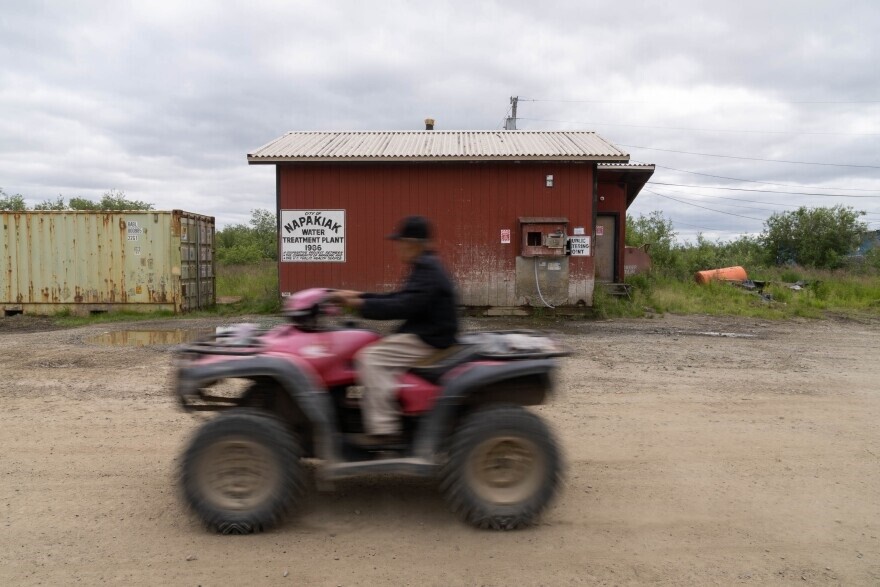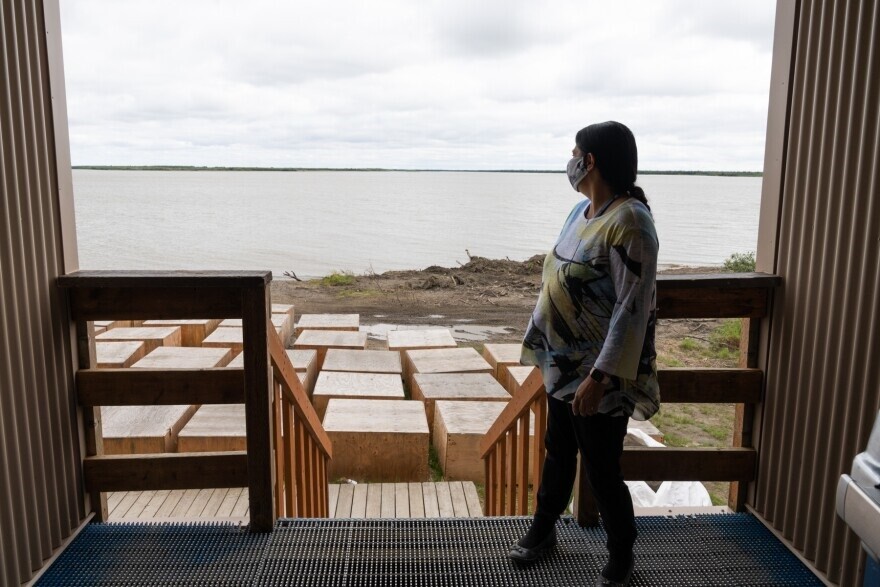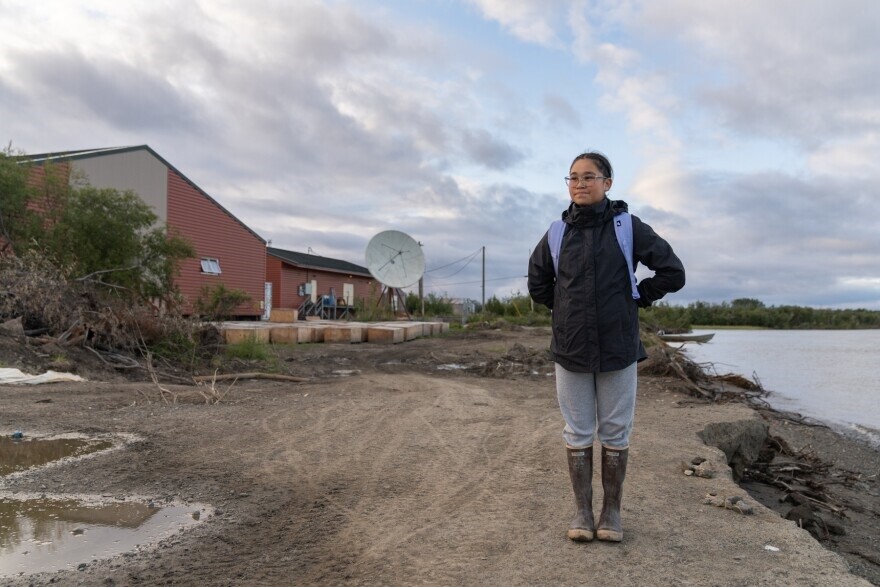This story originally appeared in the Washington Post Magazine. It aimed to bring the issue of existential environmental threats, which Napakiak and many other communities in the Yukon-Kuskokwim Delta face, to a national audience.
On the first day of school in August, Principal Sally Benedict gathered her 22 high school students to explain why they had moved from their K-12 school into a detached portable unit next door. “Technically, you guys are called displaced children,” Benedict said. “We’re doing this because of the erosion.” The William Miller Memorial School in Napakiak, a Yup’ik village on a small island in Western Alaska, is tucked in a bend of the longest free-flowing river in the United States: the Kuskokwim. The river provides the lifeblood for Napakiak’s 370 residents, but now also threatens their existence.
How long would they be in the portable building? asked one student. Until a new school is built, Benedict replied.
During high tide, the river is only 64 feet from the high-schoolers’ original classroom and gets closer by the day. On windy days, waves crash against the shore where students used to play, battering it until the land relents and crumbles. Exposed roots of willow trees and broken slabs of mud hang off the riverbank, telltale signs of erosion. The school district plans to demolish the school, or at least part of it, during this academic year before the river swallows it up.
Some students aren’t waiting around to watch that happen. The day before school started, Madison Andrew, 14, embraced her mom ahead of an approximately 12-mile boat ride to Bethel, a hub city of about 6,300 people. Uncertain whether she would have a school to attend if she stayed, she had transferred schools, leaving behind her friends, her family, and her community. “She’s pretty much my right arm, my right leg, my left arm, my left leg,” said Andrew’s mother, Jackie Grey. “She does everything from helping in the house to being there for me. So it’s like a big piece of my heart is being ripped.”

Once the school is gone, the heart of the community will be missing too. As the village’s largest building, the school hosted everything from sled-dog-racing award ceremonies, to funerals, to basketball games. In the event of spring floods, when the frozen river would thaw faster than it could drain, residents would gather in the school’s gym.
The Kuskokwim River has been eating away at Napakiak for decades; the community is accustomed to moving homes back when the water gets too close. But the school is too big to move, and the river is approaching too fast, accelerated by climate change. In a region warming two to three times faster than the rest of the world, the village is losing ground three times faster than it was 10 years ago, according to studies of Napakiak’s erosion.
The village’s senior Elder, Annie Nelson, who is 90 years old and stands under 5 feet tall, remembers sitting in a circle as a little girl with her elders. They told her that Napakiak would suffer this fate. “When the people begin to change in attitude and love starts to get cold, they predicted the weather will begin to change and erosion will start happening and people will start moving,” she tells me in Yup’ik through an interpreter. Yup’ik, meaning “real person,” refers to both a group of Alaska Native people primarily residing in Western Alaska and their Indigenous language. Although most adult villagers speak Yup’ik and English, Annie is one of the few people left in the village who exclusively speaks her native tongue.
As we speak, Annie’s great-granddaughters clean wild berries and greens they had harvested to prepare a dessert called akutaq. The young girls are continuing their ancestral traditions on their ancestral lands, a lifestyle revolving around fishing, hunting, and gathering. “They have always been here. They belong to this land. This land is their food,” 81-year-old Jacob Black, the second-oldest of the village Elders, says of the community in Napakiak.
But their lifestyle has changed in some ways too. The Yup’ik people weren’t always as stationary as they are now. They moved with the seasons, from fish camps in early summer, to berry camps in late summer, to hunting camps in the fall. “Our Elders were living their ways of life, what they call nomads,” says Black. “They move from this place to this place, where everything was abundant. That cycle, I’ll never forget.”
Their nomadic way of life changed when the United States began to enforce the requirement that Yup’ik children attend school in Western Alaska, sometime after World War II. Along with churches, schools affixed families to a single location, transforming seasonal camps into permanent, year-round communities. Now, some of those villages face the threat of being wiped away by climate change, and residents say that the government, which helped anchor them there, is not doing enough to protect them.
While growing up in Napakiak, 61-year-old Walter Nelson heard the Elders’ climate change prophecies from his mother, Annie. Now, white-haired himself, he is the coordinator of the village’s 173-page Napakiak Managed Retreat Plan, a detailed 50-year plan to move the entire community to a safe and sustainable location. The retreat is estimated to cost more than $100 million, and the village has secured less than 10% of that amount.

Annie Nelson is the senior Elder in Napakiak and remembers when the Kuskokwim River shoreline was a mile from the village. Annie is pictured at home with her great-granddaughters, Natalia Ayagalria (left) and Charlene Ayagalria (right) on July 20, 2021.
Nelson says that’s due to barriers that essentially exclude Alaska Native villages from funding sources. Some grants require fund-matching, and others call for the community to have its own heavy machinery. He says that Napakiak, where the median household income, according to the U.S. Census, is less than half the national average, simply doesn’t have the resources to manage those grant application requirements or the overhead they’d demand. To Nelson, the biggest challenge is cobbling together dozens of small grants, typically several hundred thousand dollars each. “You’re applying for this mini grant, instead of getting one big federal or state grant to take care of all your needs,” he explains.
The 2021 bipartisan infrastructure bill includes $216 million in federal funding to help tribes adapt to or relocate away from environmentally vulnerable areas. That figure pales in comparison to the $4.5 billion that the Alaska Federation of Natives estimates is needed to protect Alaska Native communities’ infrastructure over the next 50 years. And not only does the infrastructure bill’s funding for climate resilience efforts fall short in terms of dollars, says Max Neale, a senior program manager for the Alaska Native Tribal Health Consortium’s Center for Environmentally Threatened Communities, but these efforts also perpetuate programs that often ignore Alaska’s tribes. “The infrastructure bill largely provides funding to existing programs with inequitable regulatory barriers and program designs that disadvantage or exclude our communities,” Neale wrote in an email.
Napakiak is one of 73 remote Alaskan communities facing the highest level of threat due to erosion, flooding, and permafrost degradation, according to the 2019 Denali Commission Statewide Threat Assessment. Most are small Alaska Native villages. Newtok, a village in the same region that is also being displaced by a river, decided to move the entire community to another location 9 miles away. That process began decades ago and is only halfway done.


Walter Nelson is the coordinator of the village’s 173-page Napakiak Managed Retreat Plan, a detailed 50-year plan to move the entire community to a safe and sustainable location. October 22, 2021 in Napakiak, Alaska.
Nelson says the community’s biggest retreat priority right now is to make sure it still has a school. The existing one is owned by the Napakiak Corporation, the village’s business entity, and operated by the Lower Kuskokwim School District, but the state of Alaska is responsible for providing funding to build a new one. Despite the impending displacement, the state hasn’t granted the money. “The challenge for this project, and many projects, because we’ve got a long list of capital needs in the state, is resources,” says Tim Mearig, the facilities manager for the Alaska Department of Education and Early Development.
With Alaska’s finances tied directly to fossil fuel production (oil revenue supplied more than two-thirds of the state’s budget in 2020), and oil production steadily declining for decades, the amount the state has spent on school construction and maintenance has dwindled in recent years. This year, Alaska’s budget for new school construction dropped to $0. Napakiak’s new school is estimated to cost more than $40 million. Even if funding were available, Napakiak is fourth on the state’s priority list. Mearig says the communities ahead of it have unsafe or crowded schools, while Napakiak has a disaster that he says hasn’t fully arrived yet.

Napakiak School Principal, Sally Benedict, looks out at the encroaching Kuskokwim River from the school steps. Boxes of contaminated soil from the school's former fuel tanks wait to be transported out by barge.
“Why does something have to happen first in order to get some help?” asks Benedict, the school principal. Although the state has not yet funded a replacement school, it did award $3.1 million in this year’s budget to demolish the existing building to prevent it from falling into the river. The school district plans to take down half of the school this spring, hoping to preserve the gym for another year or two before the river inevitably reaches that too.
As their former classrooms turn to rubble, students will watch from portable classrooms nearby. In addition to the one they’re already using, more units will be shipped into the community; if there are obstacles in that process, the students will have to return to remote learning, Benedict says. This is a particularly painful option in Napakiak, where nobody has access to broadband Internet at home.
Yet some students have chosen to go fully remote, like Annie Nelson’s 7-year-old great-granddaughter, Evelyn Nelson. For Evelyn’s family, the decision was partially because of the pandemic but also because of Evelyn’s inability to evacuate quickly if the river reached the school suddenly during a storm. She wears leg braces because of osteoporosis. “She wouldn’t have enough time to get out of the building,” says her mother, Amanda Black. “And I know she will be scared.”
Evelyn loves school and asks to go even on weekends. Math and science are her favorite subjects. Speaking on the first day of school, Evelyn says she understands her mother’s decision to keep her home, but that doesn’t make it any easier. “River is getting close. That means no more school,” says Evelyn. “I miss school. I’ll be sad all day. I’ll miss my teacher and my friends.”

